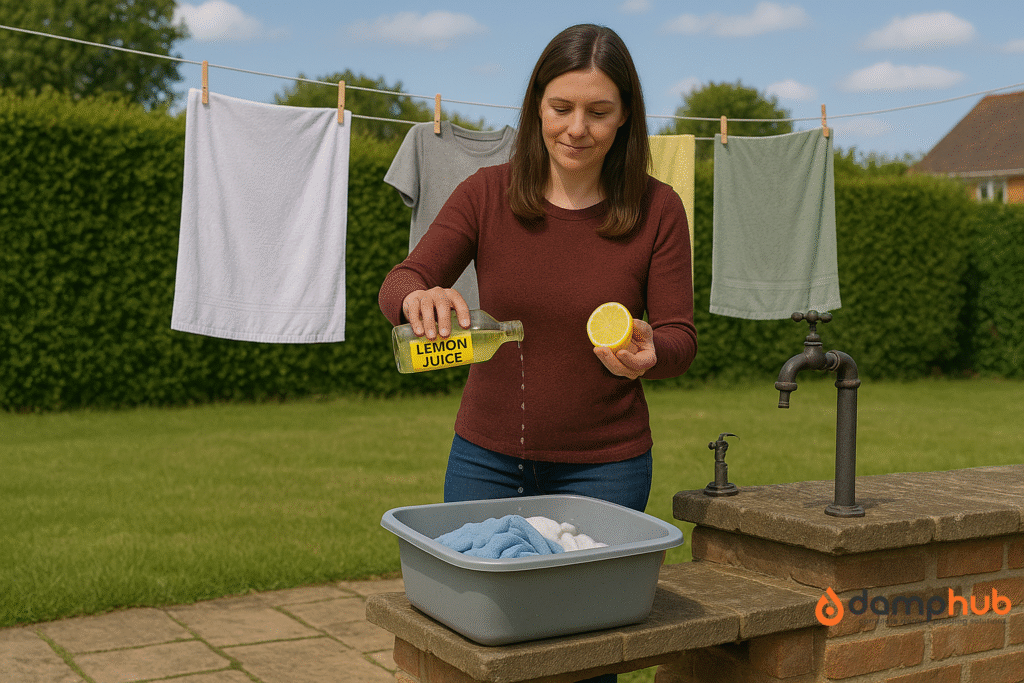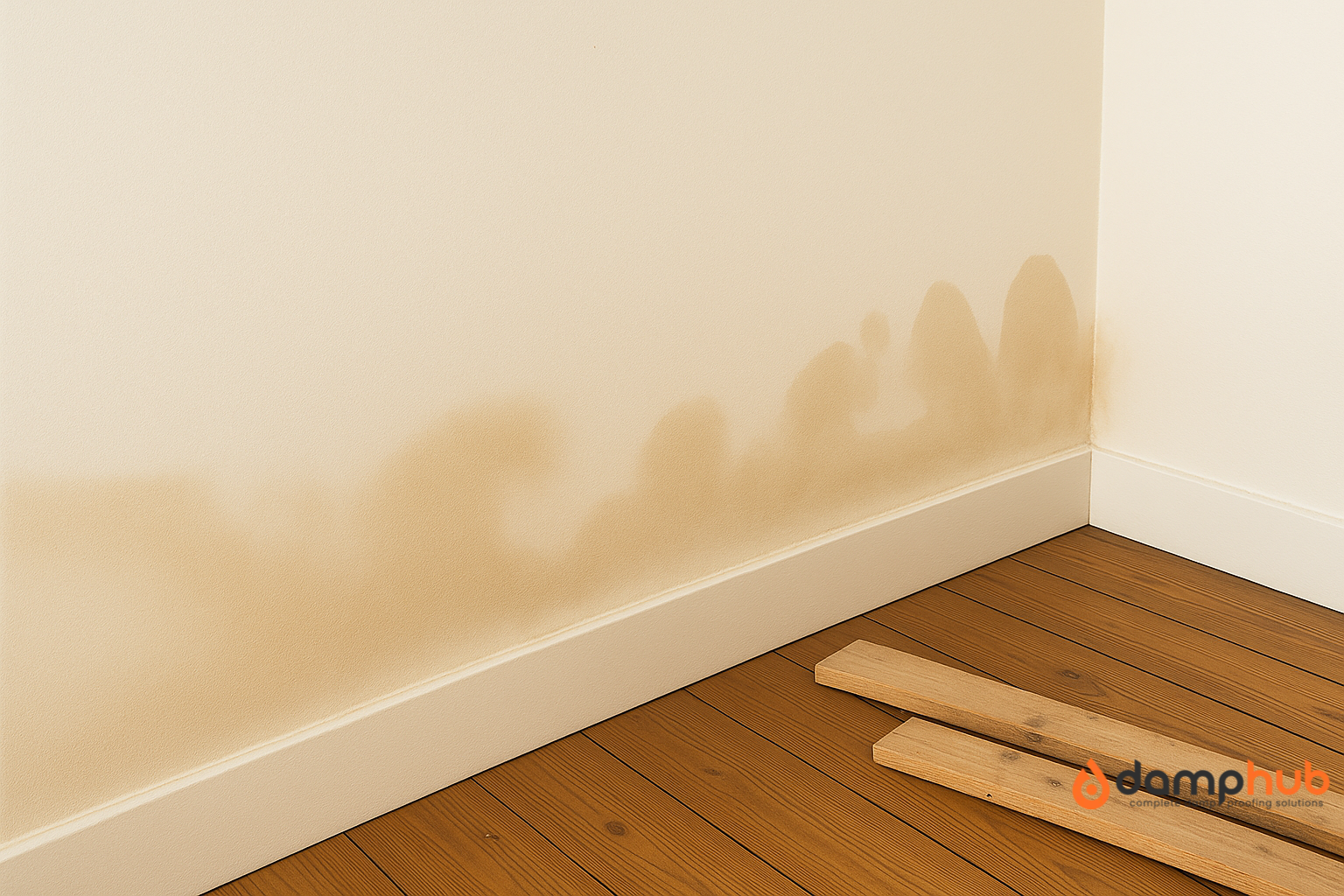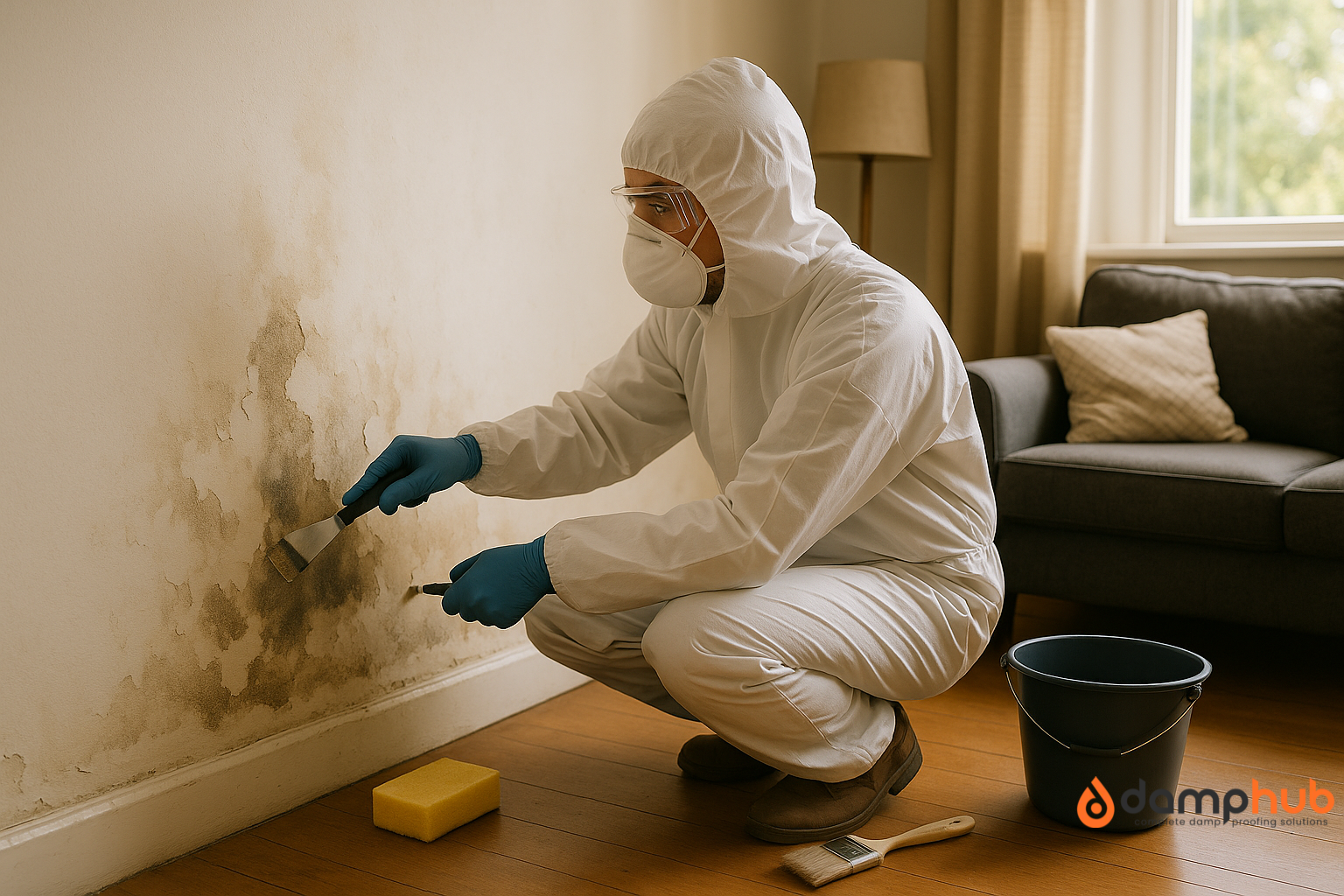
Getting rid of the damp smell in clothes can be easier than you think.
You don’t have to throw anything away.
Simple hacks like rewashing with white vinegar, adding lemon juice to your rinse cycle, or using bicarbonate of soda can remove that musty scent for good.
Drying clothes fully and keeping air flowing in storage areas also makes a big difference.
If you’re eager to know how to make that freshness last, this guide walks you through the best home remedies, deep-cleaning methods, and smart habits to keep damp smells from coming back.
How To Get The Damp Smells Out of Clothes – Washing Methods
1. Rewash with White Vinegar
White vinegar is one of the most trusted remedies for eliminating mouldy or musty odours from clothes.
The acetic acid in vinegar kills many strains of mould and bacteria and also breaks down detergent residue that can trap smells in fabric fibres.
How to use it properly:
- Add 1 cup of distilled white vinegar to the fabric softener compartment or pour it directly into the drum.
- Run a warm or hot cycle (only if safe for the fabric).
- Avoid combining vinegar with detergent in the same wash, as it reduces the effectiveness of both.
Why it works best: Unlike scented detergents that just mask smells, vinegar targets the source by killing microbial growth and dissolving built-up grime.
👉 Related Blog: How to Get Rid of Damp Carpet Odour
2. Use Baking Soda in the Wash
Baking soda (sodium bicarbonate) is a natural odour neutraliser that works by balancing pH and absorbing acidic or musty smells from fabric. It also softens water, improving detergent performance.
How to use it effectively:
- Add ½ cup of baking soda directly into the washing machine drum.
- Use it alongside your usual detergent in a full wash cycle.
- Wash on a warm setting if possible for better dissolving and absorption.
Why it’s reliable: Baking soda neutralises stubborn odours trapped in thick fabrics like towels or sportswear, especially those that have been stored in damp conditions.
3. Add Lemon Juice for Natural Deodorising
Lemon juice contains citric acid, which breaks down mould, bacteria, and soap residue. It’s mildly bleaching, making it especially useful for whites or light-coloured fabrics. It also leaves a fresh citrus scent that cuts through dampness.
How to use it:
- Mix ½ cup of freshly squeezed lemon juice with ½ cup of water.
- Pour the mixture into the fabric softener compartment or straight into the drum.
- Wash at a warm temperature unless the garment requires cold water.
- For spot treatments, apply diluted lemon juice to affected areas, let it sit for 30 minutes, then wash.
When to avoid it: Do not use lemon juice on dark or delicate fabrics—it can cause lightning or damage with repeated use.

4. Double Wash Method (For Deep Smells)
If clothes have been left damp for too long, or already smell mouldy straight from the drawer, a single wash often isn’t enough. A double wash targets the odour source more aggressively without damaging the fabric.
How to do it:
- First wash: Run a full cycle with 1 cup of white vinegar and no detergent.
- Second wash: Immediately rewash with your usual detergent and an optional ½ cup of baking soda for extra deodorising.
Important: Never mix vinegar and baking soda in the same wash — they neutralise each other and lose their effectiveness.
5. Use Odour-Eliminating Detergents
Some commercial detergents are designed to kill bacteria and remove organic odour particles that standard detergents may miss. Products like Dettol Laundry Sanitiser, Napisan, or Persil Antibacterial work well on low-temperature washes, which is useful for delicates.
When to use them:
- Clothes that retain odours even after regular washes.
- When hot water is not an option (e.g., synthetics, wool, or delicates).
- For towels, bedding, gym gear, or baby clothes exposed to high humidity.
How to apply:
- Follow dosage instructions carefully.
- Some products require pre-soaking or adding during the rinse cycle for full effect.
👉 Related Blog: How to Get Rid of Carpet Beetles in the UK
Drying Techniques That Prevent Smells from Returning
6. Air Dry in Direct Sunlight
Sunlight is one of the most effective natural disinfectants. UV rays kill mould spores and bacteria that may linger even after washing. Sunlight also helps evaporate trapped moisture more completely than indoor drying.
Tips for proper sun-drying:
- Hang clothes in direct sunlight, ideally outdoors.
- Turn garments inside out to prevent fading.
- Space items apart to allow for maximum air circulation.
- Avoid shaded or humid drying spots, which can prolong drying time and encourage musty smells.
When it’s most effective: Particularly useful for towels, heavy cottons, or items that were stored damp.

7. Use a Tumble Dryer with Dryer Sheets or Wool Balls
Tumble dryers efficiently remove moisture and prevent bacteria from surviving in damp fibres. Adding dryer sheets or essential oil-infused wool balls can neutralise any lingering smell and leave clothes fresher.
Best practice:
- Choose a heat setting appropriate for the fabric.
- Do not overload the machine—airflow is key.
- Add dryer balls with a few drops of lavender or lemon oil for a natural scent boost.
Caution: Synthetic or delicate fabrics should be tumble-dried on low heat only, or air-dried.
8. Use a Dehumidifier for Indoor Drying
Indoor drying is sometimes necessary, but it increases the room’s moisture levels, ideal for mildew growth. A dehumidifier balances the environment and accelerates drying.
How to set it up effectively:
- Place the drying rack in a small, enclosed room with the dehumidifier running.
- Keep doors and windows closed to prevent moisture from re-entering.
- Clean the dehumidifier regularly to avoid musty smells from the unit itself.
When to use it: During colder months or in flats without access to outdoor drying space.
9. Avoid Leaving Clothes Damp or In the Washer
This is one of the most common causes of damp-smelling clothes. Bacteria start multiplying within hours in moist, enclosed environments like washing machines or laundry baskets.
Avoid this mistake by:
- Setting a timer or phone alert for when the wash cycle ends.
- Removing clothes immediately and starting the drying process.
- If you forget, don’t just dry the clothes—rewash them using vinegar or lemon juice first.
Summary Table: What to Use and When
| Method | Best For | How It Helps |
| Vinegar Wash | Mild to moderate musty smells | Kills bacteria, dissolves residues, natural deodoriser |
| Baking Soda | Persistent or deeply embedded odours | Absorbs smells, balances pH, boosts cleaning power |
| Lemon Juice | Whites and fresh citrus scent | Antimicrobial, mildly brightens and refreshes |
| Odour-Eliminating Detergents | Clothes that smell after washing | Antibacterial, works at low temperatures |
| Double Wash | Strong mildew odours | Two-step removal for deep cleaning |
| Sunlight Drying | All fabrics (except delicates) | Natural disinfectant, removes moisture |
| Tumble Dryer | Fast, reliable drying | Heat and airflow remove residual dampness |
| Dehumidifier Indoors | When drying inside | Prevents moisture build-up, speeds drying time |
What Causes a Damp Smell on Clothes?
A damp or musty smell on clothing is caused by prolonged moisture exposure, which allows mould, mildew, and bacteria to grow within the fabric.
These microorganisms produce unpleasant odours as they feed on organic matter such as sweat, skin oils, and detergent residue.
The most common causes include:
1. Improper Drying
Clothes that are not dried thoroughly or quickly enough remain damp for extended periods.
This is especially common when air-drying indoors without proper airflow or using drying racks in small, enclosed rooms.
Lingering moisture creates the ideal conditions for bacterial and fungal growth.
2. Leaving Laundry in the Washing Machine
Wet clothes left sitting in the machine after the cycle ends can begin to smell in just a few hours.
The sealed, humid environment inside the drum promotes the growth of odour-causing microbes.
3. Storing Clothes Before They Are Fully Dry
Folding or hanging damp clothes in wardrobes, drawers, or laundry baskets traps moisture in the fabric.
Without airflow, this can lead to mould spores forming, particularly in clothes made from natural fibres like cotton or wool.
4. Poor Indoor Ventilation
Insufficient airflow during the drying process slows evaporation. Homes with high humidity, closed windows, or blocked air vents make it harder for moisture to escape, causing clothes to stay damp longer and increasing the risk of odour.
5. Contaminated Washing Machine
If the washing machine itself is not cleaned regularly, mould and residue can build up in the drum, rubber seals, or detergent drawer.
These contaminants can transfer to clean laundry during the rinse or spin cycle, leaving clothes smelling musty even after washing.
6. Humid Storage Conditions
Even dry clothes can develop a damp smell if stored in areas with high humidity.
Wardrobes, closets, or drawers in poorly ventilated or damp-prone areas can cause clothing to absorb moisture from the air over time.
Final Thought
If that musty smell keeps coming back, it’s not just bad luck — it’s a sign of lingering moisture and habits that need a tweak.
But you don’t have to put up with it.
Fix the root cause, and you protect more than just your clothes — you protect your home and your health.
Start with natural deodorisers like vinegar or lemon, make sure clothes are dried properly, and keep air circulating in storage spaces.
A few smart changes go a long way. Stop the smell at its source, and enjoy truly fresh laundry every time.
FAQs
Is it OK to wear clothes that smell like mildew?
No, it’s not recommended.
That smell usually means mould or mildew spores are present, which can trigger allergies, skin irritation, or respiratory issues, especially in damp conditions.
It’s best to wash and dry the clothes thoroughly before wearing them.
How long does it take to get mildew smell out of clothes?
It depends on the method used and how deeply the smell has set in.
A vinegar or bicarbonate soda wash can remove light mildew smells in one cycle.
For stronger odours, it may take a few washes or an overnight soak to fully eliminate the smell.
Is the smell of mildew harmful?
Yes, it can be.
While the smell itself isn’t toxic, it usually signals the presence of mould spores, which can be harmful when inhaled.
Prolonged exposure may lead to headaches, coughing, or allergy symptoms, especially for those with asthma or sensitivities.
How does mildew on clothes smell?
Mildew on clothes has a damp, musty, and stale scent, similar to wet towels left in a closed space.
It’s often described as earthy or sour, and it gets stronger the longer the clothes stay damp or improperly stored.
Should you throw out mouldy clothes?
Not right away.
Most mouldy clothes can be saved with deep cleaning — using vinegar, baking soda, or specialised mould removers.
But if the mould has eaten into the fabric, left stains that won’t come out, or caused damage, it may be best to throw them away.
What is the difference between mould and mildew on clothes?
Mildew is usually surface-level, greyish-white, and easier to clean.
Mould tends to be darker (black, green, or blue), can grow deeper into the fabric, and may require stronger treatment.
Both are fungi, but mould is generally more damaging and harder to remove.
Should I wash mildew-stained clothes separately?
Yes. Washing mildew-affected clothes separately prevents spores from spreading to other laundry.
Use hot water if the fabric allows, add white vinegar or an antibacterial laundry cleanser, and clean the washing machine after use.
How long does it take for mildew to grow on clothes?
Mildew can start growing in as little as 24 to 48 hours if clothes are left damp in a warm, poorly ventilated area.
That’s why it’s important to dry clothes fully and avoid leaving them in the washer or laundry basket too long.






